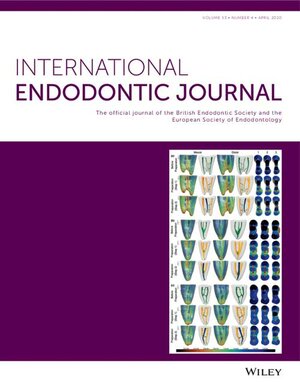Inflammatory microenvironment of moderate pulpitis enhances the osteo-/odontogenic potential of dental pulp stem cells by autophagy
Abstract
Aim
This study investigated the effects of the inflammatory microenvironment of moderate pulpitis on biological properties of human dental pulp stem cells (DPSCs) and further explored the mechanism involved in osteo-/odontogenic induction of the inflammatory microenvironment.
Methodology
Healthy DPSCs (hDPSCs) and inflammatory DPSCs (iDPSCs) were isolated from human-impacted third molars free of caries and clinically diagnosed with moderate pulpitis, respectively. Healthy DPSCs were treated with lipopolysaccharides (LPS) to mimic iDPSCs in vitro. The surface markers expressed on hDPSCs and iDPSCs were detected by flow cytometry. A CCK-8 assay was performed to determine cell proliferation. Flow cytometric analysis was used to evaluate cell apoptosis. The osteo-/odontogenic differentiation of DPSCs was evaluated by western blot, alkaline phosphatase staining, and Alizarin Red S staining. The functions of the genes of differentially expressed mRNAs of hDPSCs and iDPSCs were analysed using gene set enrichment analysis. Transmission electron microscopy and western blot were used to evaluate the autophagy changes of LPS-treated DPSCs.
Results
Compared with hDPSCs, iDPSCs showed no significant difference in proliferative capacity but had stronger osteo-/odontogenic potential. In addition, the mRNAs differentially expressed between iDPSCs and hDPSCs were considerably enriched in autophagosome formation and assembly-related molecules. In vitro mechanism studies further found that low concentrations of LPS could upregulate DPSC autophagy-related protein expression and autophagosome formation and promote its odontogenic/osteogenic differentiation, whereas the inhibition of DPSC autophagy led to the weakening of the odontogenic/osteogenic differentiation induced by LPS.
Conclusions
This explorative study showed that DPSCs isolated from teeth with moderate pulpitis possessed higher osteo-/odontogenic differentiation capacity, and the mechanism involved was related to the inflammatory microenvironment-mediated autophagy of DPSCs. This helps to better understand the repair potential of inflamed dental pulp and provides the biological basis for pulp preservation and hard tissue formation in minimally invasive endodontics.

 求助内容:
求助内容: 应助结果提醒方式:
应助结果提醒方式:


